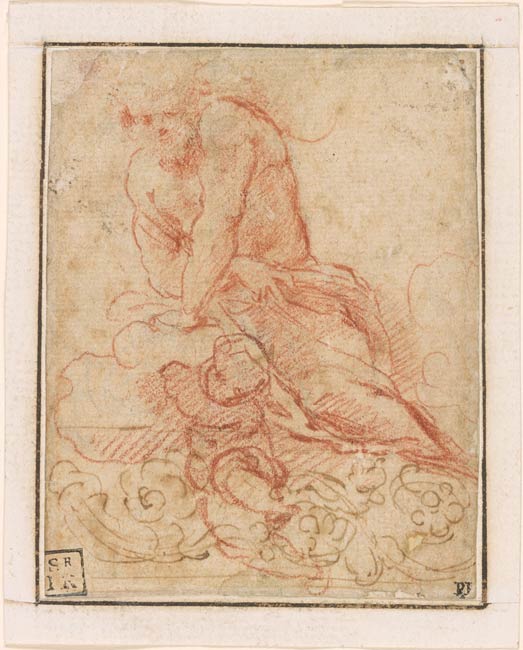
Archival documents attest that between 1520 and 1525 Correggio was working in Parma on the fresco decoration of the newly built Benedictine church of San Giovanni Evangelista.1 The oval-shaped dome, conceived by the architect Bernardino Zaccagni to cover the crossing of the church, was transformed by Correggio into a heavenly vision by means of a revolutionary fresco decoration. The risen Christ, surrounded by eleven Apostles and a multitude of putti seated on clouds, appears against a luminous sky; the scene represents the last vision of St. John the Evangelist, who is depicted at the base of the dome.
After having painted, in 1519, the Camera di San Paolo—considered a masterpiece of trompe l’oeil ceiling decoration—in the Benedictine convent in the center of Parma, Correggio obtained numerous other important commissions in the Emilian town. The dome of San Giovanni Evangelista, completed between 1520 and 1521, was immediately praised for its innovative illusionism. Some years later, the artist was assigned the even more extensive and ambitious project of the cupola in the cathedral, where Correggio painted the Assumption of the Virgin.
No textual evidence survives to document the methods employed by Correggio in planning and designing this challenging fresco decoration, which covers an area of over one thousand square feet.2 A small group of drawings related to the figures of the Apostles depicted in the dome survives, however, and sheds partial light on the artist’s working methods.3 Most of these sketches, now scattered among several collections, are small working sheets on which Correggio explored in red chalk the poses of the individual figures of the Apostles and, more rarely, of groups.4 The drawing discussed here is part of this group of preliminary studies for the cupola. The figure in the sheet given to the Morgan by Janos Scholz is related to St. Thomas. As the pose of the Apostle was later changed in the painted version, this drawing records what was probably only a first idea for the figure.5 The saint and the putto below him are sketched with rapid strokes of red chalk over an ornamental design of acanthus leaves executed in pen and ink along the bottom margin of the sheet. This motif, a scheme for the decoration of the base of the dome, was eliminated from the cupola fresco and instead employed in the drum.
This drawing, together with the other surviving sketches related to the decoration of San Giovanni Evangelista, is only a small fraction of the overall number of studies presumably produced by Correggio in preparation for the extensive fresco enterprise. It attests to Correggio’s privileged use of red chalk for his studies and the artist’s way of progressively visualizing through small sketches the details of even the most monumental and ambitiously painted decorations.
—GD
Footnotes:
- For archival documents related to the fresco decoration in San Giovanni Evangelista, see Monducci 2004, 99–104.
- On the execution of the frescoes, see Zanardi 2008, 59–79.
- For these drawings see Di Giampaolo and Muzzi 1989, nos. 13, 14, 15, 16, 17, 18, and 20, and more recently Ekserdjian 1997, 95–121. At least one other of these drawings belonged, like the Morgan sheet, to the famous collectors Peter Lely and Sir Joshua Reynolds; that sheet is now in the British Museum, London, inv. Pp. 2-10.
- Only the drawing at the Kupferstichkabinett, Berlin, KdZ 20903, represents a larger section of the dome. See Di Giampaolo and Muzzi 1989, no. 17.
- As first pointed out by Konrad Oberhuber, a further study for the same Apostle appears in the aforementioned drawing in Berlin (KdZ 20903); see Washington and New York 1973–74, no. 55.
Watermark: none visible through lining.
Preparatory study for an apostle in the fresco cycle in the cupola of S. Giovanni Evangelista in Parma, painted ca. 1520.
Lely, Peter, Sir, 1618-1680, former owner.
Reynolds, Joshua, Sir, 1723-1792, former owner.
Scholz, János, former owner.
Rhoda Eitel-Porter and and John Marciari, Italian Renaissance Drawings at the Morgan Library & Museum, New York, 2019, no. 74.
Selected references: Cologne 1963-64, no. 41; Vitzthum 1963, no. 4; Milwaukee 1964, no. 16; New Haven 1964, no. 35; New York 1965-66, no. 67; Colorado Springs 1967, no. 6; London and elsewhere 1968, no. 25; New York 1971, no. 26; Washington and New York 1973-74, no. 55; Scholz 1976, no. 33A; Notre Dame 1980, no. 142; Fellows Report 19 1981, 173; Turner 1984, 657; Di Giampaolo and Muzzi 1989, no. 19; Fornari Schianchi 1990, 78; New York and Chicago 1994, 3; New York and London 1995, 10; Ekserdjian 1997, 100; Griswold 2000, 267; Di Giampaolo 2001, no. 23; Wind 2002, 61; Rome 2008, no. 29; Rome 2016, 197.
Italienische Meisterzeichnungen vom 14. bis zum 18. Jahrhundert aus amerikanischem Besitz : Die Sammlung Janos Scholz, New York. Hamburg : H. Christians, 1963, no. 41, repr.
Stampfle, Felice, and Jacob Bean. Drawings from New York collections. I: The Italian Renaissance. New York : Metropolitan Museum of Art : Pierpont Morgan Library, 1965, no. 67.
Italian Drawings from the collection of János Scholz, exh. cat., Art Council Gallery, London; Walker Art Gallery, Liverpool; National Gallery of Scotland, Edinburgh, 1968, no. 25.
Ryskamp, Charles, ed. Nineteenth Report to the Fellows of the Pierpont Morgan Library, 1978-1980. New York : Pierpont Morgan Library, 1981, p. 173.
Oberhuber, Konrad, and Dean Walker. Sixteenth Century Italian Drawings From the Collection of János Scholz. Washington, D.C. : National Gallery of Art ; New York : Pierpont Morgan Library, 1973, no. 55, repr. (includes previous bibliography and exhibitions).
János Scholz, Italian Master Drawings, 1350-1800, from the János Scholz Collection, New York, 1976, no. 33A, repr.
János Scholz: Musician and Collector, exhibition catalogue by János Scholz, O'Shaughnessy Galleries, Snite Museum of Art, University of Notre Dame, Notre Dame, 1980, no. 142.
